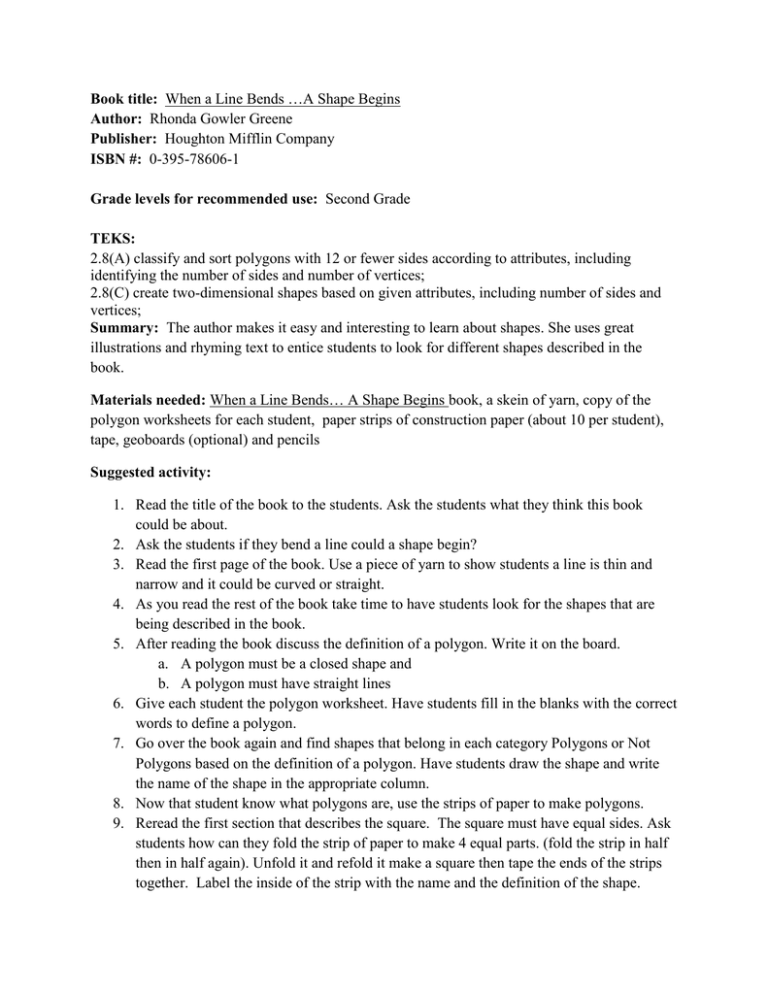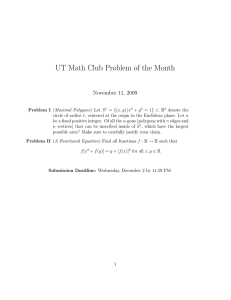Book title: Author: Publisher: ISBN #:
advertisement

Book title: When a Line Bends …A Shape Begins Author: Rhonda Gowler Greene Publisher: Houghton Mifflin Company ISBN #: 0-395-78606-1 Grade levels for recommended use: Second Grade TEKS: 2.8(A) classify and sort polygons with 12 or fewer sides according to attributes, including identifying the number of sides and number of vertices; 2.8(C) create two-dimensional shapes based on given attributes, including number of sides and vertices; Summary: The author makes it easy and interesting to learn about shapes. She uses great illustrations and rhyming text to entice students to look for different shapes described in the book. Materials needed: When a Line Bends… A Shape Begins book, a skein of yarn, copy of the polygon worksheets for each student, paper strips of construction paper (about 10 per student), tape, geoboards (optional) and pencils Suggested activity: 1. Read the title of the book to the students. Ask the students what they think this book could be about. 2. Ask the students if they bend a line could a shape begin? 3. Read the first page of the book. Use a piece of yarn to show students a line is thin and narrow and it could be curved or straight. 4. As you read the rest of the book take time to have students look for the shapes that are being described in the book. 5. After reading the book discuss the definition of a polygon. Write it on the board. a. A polygon must be a closed shape and b. A polygon must have straight lines 6. Give each student the polygon worksheet. Have students fill in the blanks with the correct words to define a polygon. 7. Go over the book again and find shapes that belong in each category Polygons or Not Polygons based on the definition of a polygon. Have students draw the shape and write the name of the shape in the appropriate column. 8. Now that student know what polygons are, use the strips of paper to make polygons. 9. Reread the first section that describes the square. The square must have equal sides. Ask students how can they fold the strip of paper to make 4 equal parts. (fold the strip in half then in half again). Unfold it and refold it make a square then tape the ends of the strips together. Label the inside of the strip with the name and the definition of the shape. 10. Read the first two sentences of the diamond. Tell students that the math name for a diamond is rhombus. Ask students what do these two shapes have in common. (equal sides) Fold the strip the same way as the square, tape and label. 11. Read the page describing the rectangle and have students make a rectangle using the strips. To make a rectangle cut a strip in half then fold put them together and fold a section (less than half of the strip). When you separate them they will look like two L’s then assemble them to look like rectangle and label. 12. Continue with the other polygon shapes triangle, octagon, and those not in the book such as hexagon, and pentagon. For fun try making the shape of the star. 13. After the shapes have been made out of the strips, use a long piece of yarn approximately 2-3 yards. Tie the ends of the yarn together. Have 2 students hold the yarn with one finger on each hand and make a square. 14. The part of the shape where the student’s fingers are a called the Vertex one or more vertex are called vertices. The sides join one vertex to another vertex. 15. Put students in groups of 3-5 students and give each group a piece of yarn to make the shapes as they fill out the 2nd worksheet. 16. Ask the students, what happens when a line bends. References: Greene, R. G. (1997). When a Line Bends…A Shape Begins. Boston: Houghton Mifflin Company. Create your own worksheets http://www.math-aids.com/Geometry/Polygons/Identify_Regular_Polygons.html http://www.math-aids.com/Geometry/Polygons/Identify_Quadrilaterals.html http://www.ezschool.com/Math/Shapes/ws7.html Games http://www.sheppardsoftware.com/mathgames/geometry/shapeshoot/QuadShapesShoot.htm Adapted by Rebecca Torres 2013 Name_______________________________Date__________________ Polygons All polygons are _______________ ______________ and have_____________________ _______________. Polygon Not a Polygon Name____________________________Date____________________ Sides and Vertices A vertex is a corner. More than one vertex are called vertices. A side joins one vertex with another. Name of Number of Number of Shape Sides Vertices




